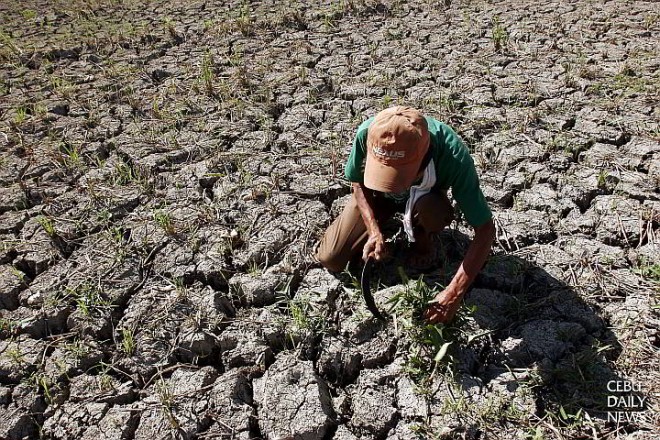
During a dry spell in April 2007, a farmer struggles to tend to his rice paddy in Carcar town, south Cebu.
The dry spell in the country will worsen in the coming months, continuing the drought in many provinces and possibly triggering stronger storms, the weather bureau warned on Friday.
The Philippine Atmospheric Geophysical Astronomical Services Administration (Pagasa) on Friday said the El Niño phenomenon, or the warming of ocean temperatures that is causing the dry spell, is expected to intensify from August to December. This will mean that most parts of the country will get less than the usual rainfall during the rainy season.
More than 50 provinces that have been experiencing drought (less than 60-percent their normal rainfall) and dry spell conditions (20 to 59 percent less than usual rainfall) since the start of the year are counting on getting relief when the rainy season starts in mid-June.
But in its latest bulletin dated May 27, Pagasa said relief in June and July may be short-lived. In a news conference, Pagasa announced that the weak El Niño affecting the country since early this year will intensify to moderate strength after August.
Weather forecasters warned that the El Niño, a weather phenomenon characterized by unusually warm sea surface temperatures in the Pacific Ocean, could also cause stronger storms.
The weather bureau reported 43 provinces currently experiencing drought while 17 others are experiencing a dry spell. Of these, 47 provinces may expect rains in June but 13 provinces will continue to suffer from lack of rain.
The provinces that may suffer lack of rain are: Apayao, Bataan, Benguet, Bulacan, Ilocos Norte, La Union, Palawan, Pampanga, Rizal, Sarangani, South Cotabato, Tarlac and Zambales.
From August to December, seven provinces will experience drought while 54 others, including Metro Manila, will experience a dry spell, the weather bureau said.
The seven provinces that could experience drought are Cebu, Marinduque, Camarines Norte, Camarines Sur, Palawan, Biliran and Leyte.
“We are seeing the impact of a very dry condition from August onwards,” Pagasa climatologist Anthony Lucero said, adding that most areas in the country will have below normal rainfall.
Pagasa said the country will still get “ample” rain in June, with at least one to two cyclones expected to hit the country.
By July, however, rainfall will start to decrease in many parts of the country as the southwest monsoon that marks the rainy season will be confined in the northern provinces.
The areas affected by decreased rainfall will widen in August and September.
“In October we will feel the full impact of El Niño,” Lucero warned.
The weather bureau said the El Niño will last until May next year, although it is expected to start to weaken by the start of 2016.
Pagasa hydrologist Elmer Caringal said the expected rains in June and July will replenish Angat Dam back to its normal operating level of 212 meters above sea level.
The dam has recently fallen below the 180-meter critical level which meant authorities have to stop releasing water to irrigate farmlands in Bulacan and Pampanga.
RELATED STORIES
Dry spell: Calamity declared in 5 towns
16 provinces told to brace for drought, dry spell in May
Cebu rural farmers prep for dry spell

